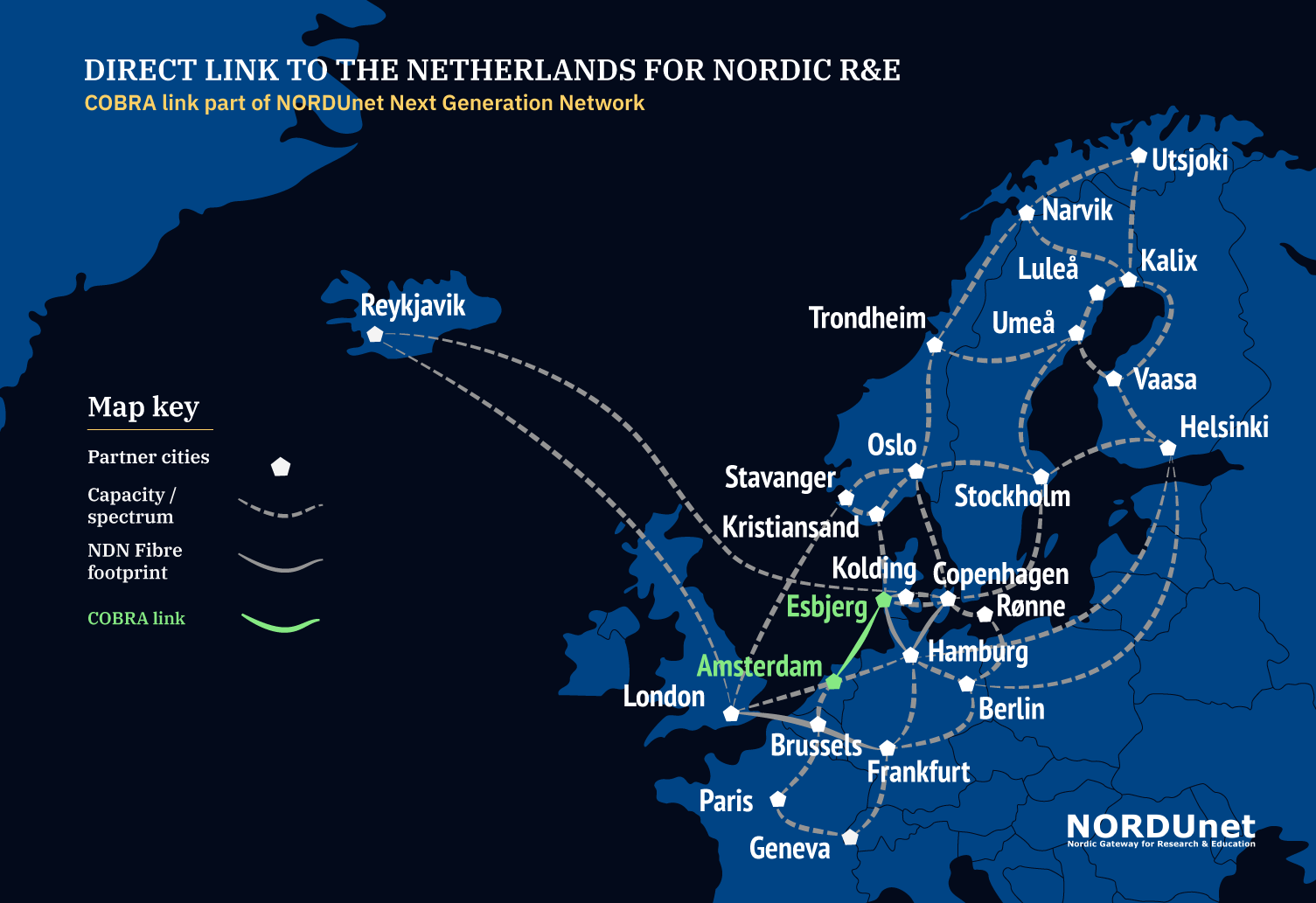
Services
NORDUnet provides a wide range of services for the Nordic research and education community, both core network services, above-the-net services, and logistics-related services, both highly technical and non-technical in nature
NORDUnet provides a wide range of services for the Nordic research and education community, both core network services, above-the-net services, and logistics-related services, both highly technical and non-technical in nature
NORDUnet operate a global network that interconnects the research and education networks in the Nordic countries, and connect these network to the rest of the world. NORDUnet operate on behalf of the five Nordic NRENs.
Science has always been international in scope. Research and education is increasingly a global effort, unfolding in partnerships with global stakeholders in global projects, using scientific instruments or teaching resources unrestricted by borders.
NORDUnet Events range from workshops, bigger community gatherings to once every two years NORDUnet Conference. Apart from sharing knowledge people from the Nordic Research and Education community have the opportunity to meet and catch up. The number of participants keeps rising – underlining the importance of meeting in real life.
More than 400 research & education institutions in the Nordics, with over 1.2 million users, are connected via the Nordic NREN networks, enabling scientists, educators, and students to work and share knowledge globally.
More than 400 research & education institutions in the Nordics, with over 1.2 million users, are connected via the Nordic NREN networks, enabling scientists, educators, and students to work and share knowledge globally.
Read more>>
NORDUnet and the Nordic NRENs are proud members of a global family of research and education networks, each serving their own country or region. Together, the world’s R&E Networks form the Global Research & Education Network (the GREN), enabling the global collaboration of modern research, or in other words “So that Luiz’ research team in Mexico City can connect to Greta’s team in Oslo using data housed in Melbourne” and trans-national education.

The network layer of the GREN offers unmatched capacity across the globe, across oceans and, through the local R&E Network, to individual institutions. Providing this requires each of the partners, the NRENs in every country, to have a high-speed network. But individual networks are not enough. To offer a comprehensive and integrated GREN also requires extensive collaboration and coordination between the NRENs across the world and their regional networks.
Our long-time partner CANARIE – Canada’s National Research & Education Network – has masterminded a testimony of global efforts in the Research and Education community. Experience the power of the GREN in just 3 minutes.
It all started back in 2012, when Internet2, SURFnet, ESnet, and NORDUnet initiated a collaboration to secure bandwidth and redundancy across the North Atlantic Ocean.
The idea was to challenge the market, while aiming at taking intercontinental bandwidth a big step forward, in order to move from the present situation with many 10 Gbit/s links towards a couple of 100 Gbit/s links, carefully acquired taking optimal price points and maximum resilience into consideration.
The initial single 100G link between Amsterdam and New York City developed into a brand-new way of collaborating among NRENs, sharing the capacity. CANARIE and GÉANT joined the collaboration, that has grown strong and now consists of six NRENs, with a steering group and associated working groups on operations, technology, cost sharing, and legal matters.
ANA became a pathfinder of innovative collaboration models for R&E Networks, and similar initiatives have since developed:
Other initiatives are in the making.
Today, we have a sustained ANA capacity of 800 Gbit/s, with two additional temporary 100 Gbit/s added, yielding a total of 1,000 Gbit/s (= 1 Tbit/s) available for users in R&E between Europe and North America.
A joint global effort was needed to coordinate the establishment of intercontinental connections, and this gave birth to Global Network Architecture (GNA), later on merged with the Global Lambda Integrated Facility (GLIF) into Global Network Advancement Group (GNA-G).
Around 2012, the time had come for the global R&E Network community to join forces and define a common global architecture for the future R&E network interconnect, a crucial aspect of the GREN.
By then, an innovative forefront of engineers in GLIF had successfully invented, tested, and produced numerous concepts for the R&E infrastructure to enable the transfer of heavy data loads produced by new science facilities like the Large Hadron Collider (LHC), which in this case led to the LHC Optical Private Network (LHCOPN).
These concepts formed a solid foundation for the global NREN community facing their next challenge. Modern science desperately needed the ever-increasing supply of fast and resilient network bandwidth, not just within a country or region, but all over the planet. Hence, the Global Network Architecture movement was established to coordinate and integrate all the different network solutions, to ensure a consistent standard for the future GREN. NORDUnet was one of the instigators and, still today, contributes to further enhancing the intercontinental infrastructure for Research and Education. The major driver for this is that both science, research, and education, have become global endeavors, that require ubiquitous, fast, resilient, and cost-effective connectivity.
One goal – one collaboration
In 2019, GNA and GLIF merged their efforts into one activity: The Global Network Advancement Group, or GNA-G for short.
NORDUnet A/S – Kastruplundgade 22 DK – 2770 Kastrup DENMARK
Phone +45 32 46 25 00 | Mail info@nordu.net | Privacy policy
| Cookie | Duration | Description |
|---|---|---|
| cookielawinfo-checkbox-analytics | 11 months | This cookie is set by GDPR Cookie Consent plugin. The cookie is used to store the user consent for the cookies in the category "Analytics". |
| cookielawinfo-checkbox-functional | 11 months | The cookie is set by GDPR cookie consent to record the user consent for the cookies in the category "Functional". |
| cookielawinfo-checkbox-necessary | 11 months | This cookie is set by GDPR Cookie Consent plugin. The cookies is used to store the user consent for the cookies in the category "Necessary". |
| cookielawinfo-checkbox-others | 11 months | This cookie is set by GDPR Cookie Consent plugin. The cookie is used to store the user consent for the cookies in the category "Other. |
| cookielawinfo-checkbox-performance | 11 months | This cookie is set by GDPR Cookie Consent plugin. The cookie is used to store the user consent for the cookies in the category "Performance". |
| viewed_cookie_policy | 12 months | The cookie is set by the GDPR Cookie Consent plugin and is used to store whether or not user has consented to the use of cookies. It does not store any personal data. |